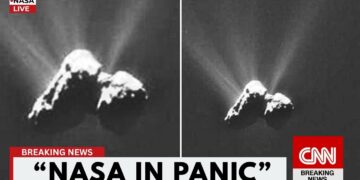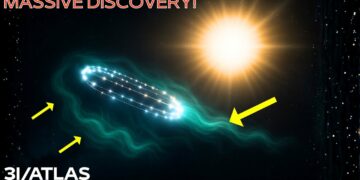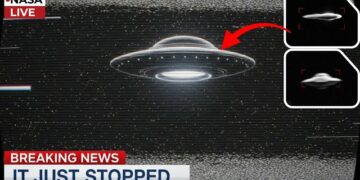A mysterious object, dubbed Three Eye Atlas, is hurtling toward Earth at 130,000 mph, sparking intrigue and speculation. Elon Musk has confirmed that this isn’t just another space rock, igniting debates about whether it could be evidence of extraterrestrial technology. This cosmic anomaly is challenging our understanding of the universe, turning astronomy into something resembling science fiction.
First spotted in July 2025, Three Eye Atlas defies the laws of physics. Astronomers worldwide have abandoned routine work to study it, knowing it may vanish forever after passing behind the sun in October. Unlike typical asteroids or comets, which orbit slowly enough for long-term study, this object moves too fast for the sun’s gravity to hold, following a hyperbolic path that suggests origins in a distant, ancient part of the galaxy. Its speed—covering the distance between Jupiter and Mars in just 16 weeks—implies it formed in stellar conditions unlike anything in our solar system, possibly billions of years ago when the Milky Way was younger.
Before its official discovery, a satellite meant for exoplanet hunting accidentally captured Three Eye Atlas in May, recording it performing “impossible tricks” for three weeks. These images, unnoticed until later, revealed an object radiating energy far beyond where comets typically activate, defying centuries-old principles of comet behavior. Normally, comets begin sublimating ice into gas near Jupiter’s orbit, creating visible tails. Three Eye Atlas was already glowing brightly in the frigid outer solar system, where nothing should be active, with its luminosity intensifying as it moved inward.
Even more bizarre, its tail grows toward the sun, defying the solar wind that pushes comet tails outward. This suggests an internal force strong enough to overpower one of the universe’s fundamental mechanisms, a phenomenon with no known natural explanation. Its chemical makeup is equally baffling. The James Webb and Hubble telescopes detected a gas cloud dominated by carbon dioxide—eight molecules for every one of water vapor—reversing the water-heavy composition of typical comets. This cloud spans 300,000 km, nearly half the sun’s diameter, indicating a massive outgassing process from a core possibly 46 km wide.
Spectroscopic analysis by Chile’s Very Large Telescope revealed an even stranger anomaly: the presence of nickel in the gas cloud, but no iron. In nature, these metals are forged together in stellar cores and always appear together in cosmic objects. Finding nickel without iron is like finding a shadow without its source, suggesting either an unknown natural process or deliberate artificial separation. This has fueled speculation, though rarely voiced publicly, that Three Eye Atlas might not be natural at all.
Compared to earlier interstellar visitors like ‘Oumuamua (2017), which showed no comet-like activity despite nearing the sun, and 2I/Borisov (2019), which behaved like a typical comet, Three Eye Atlas is far stranger. Its velocity, luminosity, chemical composition, and metallic paradox challenge our understanding of physics, chemistry, and cosmic evolution. If representative of other interstellar objects, it suggests our solar system may be frequently visited by undetectable “cosmic bullets,” reshaping theories about material exchange between stars and even the origins of life.
As Three Eye Atlas races through our solar system, scientists are racing against time to study it before it disappears. Its implications—whether natural or artificial—could redefine our place in the cosmos. What do you think about Three Eye Atlas? Share your thoughts below.
























